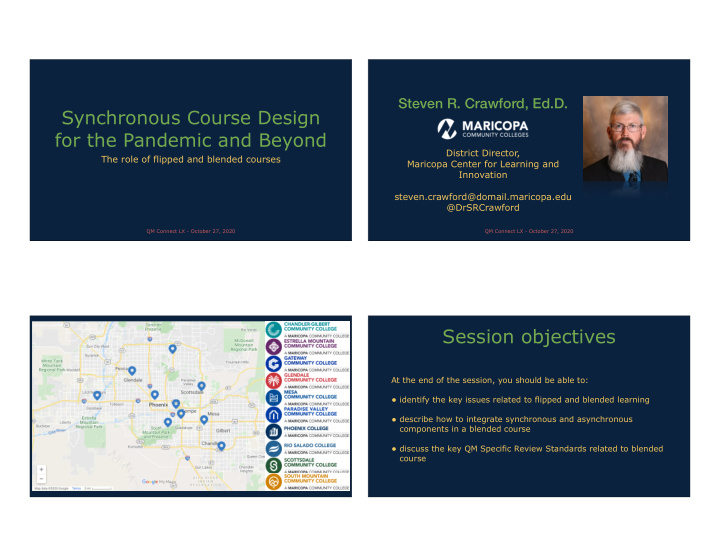



Steven R. Crawford, Ed.D. Synchronous Course Design for the Pandemic and Beyond District Director, The role of flipped and blended courses Maricopa Center for Learning and Innovation steven.crawford@domail.maricopa.edu @DrSRCrawford QM Connect LX - October 27, 2020 QM Connect LX - October 27, 2020 Session objectives At the end of the session, you should be able to: • identify the key issues related to flipped and blended learning • describe how to integrate synchronous and asynchronous components in a blended course • discuss the key QM Specific Review Standards related to blended course
Key Terms Virtual classroom Circa 2007
Examples of asynchronous learning Examples of synchronous learning Formative & Summative What do the QM Standards Assessment say about blended learning?
Specific Review Standards Reduction of seat time 1.1 - Instructions make clear how to get started and where to find various course Traditional face-to-face 3-credit hour course components. 1.2 - Learners are introduced to the purpose and structure of the course. Classroom Time Homework Time Online Time Total Time 1.8 - The self-introduction by the instructor is professional and is available online. 3 hours 6 hours 9 hours 1.9 - Learners are asked to introduce themselves to the class. Blended 3-credit hour course (33% reduced seat time) 2.3 - Learning objectives or competencies are stated clearly, are written from the learner’s perspective, and are prominently located in the course. Classroom Time Homework Time Online Time Total Time 4.2 - The relationship between the use of instructional materials in the course and completing learning activities is clearly explained. 2 hours 6 hours 1 hour 9 hours 5.2 - Learning activities provide opportunities for interaction that support active learning. Reduction of synchronous time Traditional face-to-face 3-credit hour course Synchronous Time Asynchrounous Time Total Time How does this influence 3 hours 6 hours 9 hours course design? Blended 3-credit hour course (33% reduced synch time) Synchronous Time Asynchrounous Time Total Time 2 hours 7 hours 9 hours
Approaching synchronous time Creating a course flow between modalities Asynchronous Synchronous • Pre-class preparation (asynchronous time) • Class time - either via video conferencing or in-person (synchronous time) • Post-class wrap-up/reflection (asynchronous time) Purposeful integration Course planning chart Synchronous Learning Activity Modality Assignment Assessment Class Topic(s) Pre-class Activity Assignment Due Activity Objective View online lecture Discuss ISD Online quiz (before Use the View video Asynchronous 1. Demonstrate 1. Develop a process synchronous time) Instructional lectures comprehension of unit of Review ISD process 1 Systems of the ISD training using Form groups and Groups submit topic Use the Design (ISD) process the ISD Online quiz explore training area for training unit Read over Asynchronous Instructional process to process unit topics sample plans Systems Design develop a unit 2. Develop a unit of View online Develop Submit assessment (ISD) process to of training training using the presentation on using assessment plan plan (post- Complete Asynchronous develop a unit ISD process ISD process synchronous time) knowledge of training 2 Present plan to quiz Assemble resources to class In groups, Synchronous develop assessment develop plan training model
Resources Resources Synchronous course design for the pandemic and beyond: The role of flipped and blended courses Steven R. Crawford, Ed.D. District Director, Maricopa Center for Learning and Innovation steven.crawford@domail.maricopa.edu @DrSRCrawford QM Connect LX - October 27, 2020
Recommend
More recommend